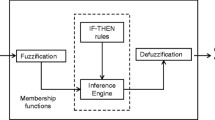Abstract
This paper describes a method that allows farmers to (i) decide whether or not the spatial variation of a field allows a reliable variable-rate application, (ii) discover if a particular threshold (field segmentation) based on within-field data is technically feasible according to the application machinery and (iii) make an appropriate application map. Our method aims to improve on a previous technical opportunity index (Oi) with a fuzzy technical opportunity index (FTOi). The FTOi considers (i) a fuzzy footprint model of a variable-rate application controller (VRAC), which describes the area within which the VRAC can operate reliably, (ii) the location inaccuracy of the data and (iii) the ability (accuracy) of the VRAC to perform distinct levels of treatments. The originality of our approach is based on the use of a fuzzy estimation process to decide if a level of treatment is reliable or not for each area over which the VRAC operates. A unique feature of the approach is that it does not require data on a regular grid. Only characteristics of the machinery and the treatment to be applied are necessary; interpolation of the data and geostatistics are not required by the end user. Tests on theoretical fields, obtained from a simulated annealing procedure, showed that the FTOi was able to assess the technical manageability of variation in the field. Tests also showed that our approach could take into account problems related to low resolution data. Finally, the approach has been applied to a real situation in a vineyard block. This has highlighted the practical implementation and the ability to generate useful information for managing the within-field variation (optimal thresholding, and application and error maps).












Similar content being viewed by others
References
Acevedo-Opazo, C., Tisseyre, B., Guillaume, S., & Ojeda, H. (2008). The potential of high spatial resolution information to define within-vineyard zones related to vine water status. Precision Agriculture, 9, 285–302.
de Olivera, R. P., Whelan, B. M., McBratney, A. B., & Taylor, J. A. (2007). Yield variability as an index supporting management decisions: YIELDEX. In J. V. Stafford (Ed.), Precision Agriculture ’07 (pp. 281–288). Wageningen, The Netherlands: Wageningen Academic Publishers.
Deloire, A., Carbonneau, A., Wang, Z., & Ojeda, H. (2004). Vine and water: A short review. Journal International des Sciences de la Vigne et du Vin, 38, 1–13.
Dubois, D., & Prade, H. (1988). Possibility theory. New York: Plenum Press.
Goovaerts, P. (1997). Geostatistics for natural resources evaluation. Applied geostatistics series. New York: Oxford University Press.
Paoli, J.-N., Strauss, O., Tisseyre, B., Roger, J.-M., & Guillaume, S. (2007). Qualitative spatial estimation of fuzzy request zones. Fuzzy Sets and Systems, 158, 535–554.
Pringle, M. J., McBratney, A. B., Whelan, B. M., & Taylor, J. A. (2003). A preliminary approach to assessing the opportunity for site-specific crop management in a field, using yield monitor data. Agricultural Systems, 76, 273–292.
Taylor, J., Tisseyre, B., Bramley, R., & Reid, A. (2005). A comparison of the spatial variability of vineyard yield in European and Australian production systems. In J. V. Stafford & A. Werner (Eds.), Precision agriculture ’05 (pp. 907–915). Wageningen, The Netherlands: Wageningen Academic Publishers.
Tisseyre, B. (2003). La viticulture de précision, vers une connaissance très affinée des moyens de production. In Institut Rhodanien (Eds.), Actes des 7èmes rencontres rhodaniennes (pp. 25–34). institut rhodanien.
Tisseyre, B., Mazzoni, C., & Fonta, H. (2008). Within-field temporal stability of some parameters in viticulture: Potential toward a site specific management. International Journal of Wine and Vine Research, 42, 27–39.
Tisseyre, B., & McBratney, A. B. (2008). A technical opportunity index based on mathematical morphology for site-specific management using yield monitor data: Application to viticulture. Precision Agriculture, 9, 101–113.
Acknowledgments
Alex McBratney acknowledges the support of the Australian Research Council and the (Australian) Grains Research & Development Corporation.
Author information
Authors and Affiliations
Corresponding author
Rights and permissions
About this article
Cite this article
Paoli, J.N., Tisseyre, B., Strauss, O. et al. A technical opportunity index based on the fuzzy footprint of a machine for site-specific management: an application to viticulture. Precision Agric 11, 379–396 (2010). https://doi.org/10.1007/s11119-010-9176-3
Published:
Issue Date:
DOI: https://doi.org/10.1007/s11119-010-9176-3




